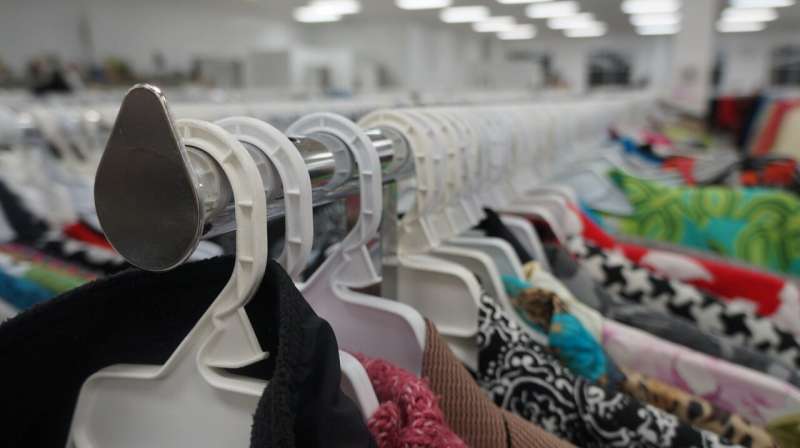This article has been reviewed according to Science X's editorial process and policies. Editors have highlighted the following attributes while ensuring the content's credibility:
fact-checked
trusted source
written by researcher(s)
proofread
Understanding 'underconsumption core': How a new trend is challenging consumer culture

A new TikTok trend called "underconsumption core" is gaining traction online. This trend champions minimalism and frugality, and encourages people to maximize the utility of their purchases and buy only what they truly need, challenging the culture of consumerism.
Instead of showcasing large hauls of clothing, makeup or over-flowing fridge shelves, users are posting videos showing thrift store purchases, modest wardrobes and practical, well-used everyday items.
The rise of this trend can be linked to several challenges facing young people today, including increasing economic pressures, environmental concerns and social pressures, all of which are particularly affecting Gen Z and younger Millennials. If you're also feeling financially squeezed, this trend might resonate with you.
Similar to the deinfluencing trend, underconsumption also appears to be a reaction to overconsumption—especially the way influencers have normalized it by posting haul videos. By promoting underconsumption, online users are rejecting and pushing back against this aspect of "influencer culture."
Born of necessity
Young people are likely engaging with it as a way to adapt to increasing financial pressures.
For instance, the average federal student loan debt balance in the United States is US$37,574 per borrower, according to the Education Data Initiative. Student debt is a significant financial burden that often forces young adults to prioritize debt repayment over discretionary spending.
Inflation is also continuing to erode Gen Z's purchasing power. While there are signs of economic relief, such as interest rate cuts in Canada, the cumulative effects of high prices continue to strain young peoples' budgets.
Underconsumption core represents a growing awareness and adaptation to these economic realities, but it's not the only reason. Another driver of the underconsumption trend appears to be environmental consciousness.
Environmental concerns
Mass consumerism has created significant environmental problems, including the generation of vast amounts of waste. In Chile's Atacama Desert, an estimated 11,000 to 59,000 tons of used clothing is sitting in a landfill. This is just one example of how overconsumption is polluting the environment.
A report from ThredUp, an online vintage-resale platform, found that 65 percent of Gen Z respondents wanted to shop more sustainably. However, one-third felt "addicted to fast fashion," and 72 percent said they shopped for fast fashion in 2022. Similarly, researchers from Sheffield Hallam University found 90 percent of university students bought fast fashion in 2022.
Despite this, many of these same consumers are concerned with sustainability and are actively seeking ways to be more responsible. Our recent study found a consistent shift in consumer attitudes towards sustainability practices, especially in fashion. This is particularly the case with Gen Z, who rely heavily on social media for shopping inspiration.
As younger consumers become more aware of the environmental impact of their purchasing decisions, they are increasingly drawn to sustainable fashion content.
This shift in consumer mentality aligns with the broader cultural phenomenon known as the "Marie Kondo effect," named after the Japanese organizing consultant. She is an advocate for only keeping things that bring one value and joy. Kondo's influence has sparked a growing interest in intentional consumption.
However, it is important to note that, in some instances, sustainable consumption behaviors may be driven more by selfish motives than purely altruistic ones. By choosing to consume less or more mindfully, younger individuals can project an image of thoughtfulness, responsibility and uniqueness—qualities that are increasingly valued in the social media landscape.
How to be a healthier consumer
If you are interested in practicing healthier consumption habits, it's important to understand how you can sustain this lifestyle long-term. There are two main strategies you can use to do this.
First, find a way to strike a balance between frugality and quality of life to maintain your overall well-being. Research suggests a mix of experiential spending (such as travel) and material purchases (such as a new smartphone) can lead to greater happiness and satisfaction.
Don't completely abandon material purchases in favor of experiences. Instead, a thoughtful approach that includes both types of spending, albeit at a reduced overall level, will likely lead to better outcomes. This approach focuses more on mindful consumption, rather than blanket restrictions.
Second, try to focus on improving your financial literacy. Start by creating a budget that ensures basic needs and baseline expenses are met. Seek to understand the types of financial products and solutions that fit your particular needs. This will help you avoid overconsumption and make choices that support long-term financial stability.
Those with higher financial literacy are better equipped to select products that align with their needs and values, rather than falling prey to aggressive marketing or unnecessary features that can lead to overconsumption. For instance, young consumers are likely to spend more on credit cards that offer attractive rewards leading to overconsumption and strained budgets over the long-term.
While the underconsumption trend offers potential benefits, it's important to approach it in a balanced way. While combining healthy spending habits with financial literacy is key, it shouldn't be about deprivation. Instead, you should make informed choices that align with your personal values and goals. Done right, underconsumption can lead to financial stability and a more purposeful lifestyle.
Provided by The Conversation
This article is republished from The Conversation under a Creative Commons license. Read the original article.![]()





















